‘World Class’ Research Is Answering Questions About Fish Habitat, Hatcheries, and Genetics
By: John Harrison
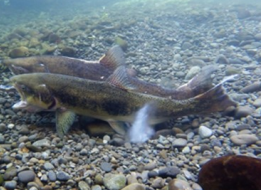
Photo: Kevin Belcher
Fish and wildlife research sponsored through the Council’s Columbia River Basin Fish and Wildlife Program into the effects of the ocean, estuary, hatcheries, and habitat on salmon and steelhead survival not only is producing interesting and useful results but is some of the best of its kind in the world, the Chairman of the Council’s Independent Scientific Review Panel (ISRP) said at the Council’s October 2018 meeting.
“The research that’s going on in the basin is terrific,” ISRP Chair Steve Schroder said. Schroder, who lives in Olympia, is a former research scientist with the Washington Department of Fish and Wildlife.
Erik Merrill, who coordinates the work of the Council’s two independent scientific groups, the ISRP and the Independent Scientific Advisory Board (ISAB), said the purpose of the ISRP research status review was to look at the progress of addressing the critical uncertainties identified in the Council’s 2017 research plan. While not a part of the Fish and Wildlife Program, the Research Plan serves as guidance to federal agencies with legal responsibilities under the Northwest Power Act in implementing the research measures and priorities of the Program.
The ISRP reviewed 25 research projects. Schroder said the review showed there is collaboration occurring among the projects, that uncertainties in 13 out of the 14 major topic areas in the 2017 Research Plan are being addressed, and that results for many of the projects had been extensively published.
The 25 projects are in three categories: 1) the growth, survival, or migration, and genetic diversity of fish populations; 2) limiting factors and the effectiveness of habitat restoration efforts; and 3) fish propagation – methods to improve fish culture and assess how successful hatcheries have been in supplementing populations of steelhead and spring Chinook salmon.
“Research that is occurring in the basin is innovative and often leads the way for other similar studies around the world,” Schroder said.
Growth, Survival, and Genetic Diversity
Consider Passive Integrated Transponder (PIT tags). These tiny devices, the size and shape of a grain of rice, are inserted in the bellies of juvenile fish and have been used for years to track the survival, abundance, and migration rates of both juvenile and adult fish. “But recently, there is a decline in the capacity of the detection system in the mainstem Columbia and Snake rivers to pick up PIT-tagged fish,” Schroder said. “Detection rates have dropped from almost 100 percent down to about 50.”
A PIT tag, which is small enough to be inserted in the gut of a juvenile fish, contains information about where the fish was raised and released.
The answer, research showed, has to do with increased spill. As more juvenile fish are passed over dam spillways to avoid passing through turbines, they are diverted away from bypass systems where their PIT tags would be detected.
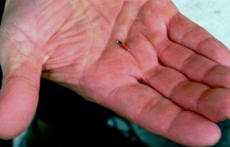
“Right now there is really no way to detect fish that go through spillways,” Schroder said.
However, he said the Corps of Engineers is going to try “a kind of amazing” experiment with PIT tag detection in a spillway at Lower Granite Dam using an array of 11 detectors.
“I want you to imagine that you’re a fish and that you are going 40 to 50 miles an hour down this spillway, and the water depth is about two and a half feet. Can you imagine what that must be like?” he said. “And, imagine the challenge of trying to detect the PIT tag in a small fish going 50 miles an hour.”
A new device, developed through research, is a vertical wand detector that can record PIT tags as fish pass at different depths. The device is being tested in the Walla Walla and Yakima rivers, and in the lower Columbia downstream of Bonneville Dam, where Schroder said “detection has been a real black box for many, many years,” adding, “it’s real exciting stuff that’s going on.”
Another big black box, he said, is the ocean. NOAA Fisheries began conducting ocean surveys in 1998 to examine how ocean conditions affect the survival, growth, and migration rates of juvenile salmon.
“We knew ocean conditions were affecting survival, but we didn’t know how or why,” he said. “Ocean conditions really are one of the overwhelming drivers of salmon survival. If the fish go out in poor ocean conditions they survive very poorly.”
According to the Comparative Survival Study, neither Snake River wild spring/summer Chinook nor wild steelhead populations, nor hatchery fish of these species, appear to consistently meet the 2-4 percent SAR goal in the Council’s Fish and Wildlife program. The same can be said for Snake River sockeye, and for most wild and hatchery steelhead, Chinook, and sockeye in the middle and upper Columbia rivers. That’s not true for all species, according to the study, notably steelhead in the John Day, Umatilla, and Deschutes rivers, which have consistently higher SARs than other species and meet the Council’s goal more often, if not every year.
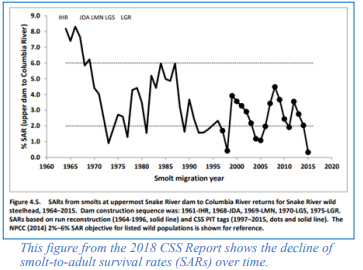
“The expansion of genetic methods has been extraordinary,” Schroder said. “Scientists in the basin can now address questions that would have been impossible to answer in the recent past.” Genetic samples collected from salmon and steelhead as they pass Bonneville Dam are being used to track fish migration timing and abundance. Genetic baselines also have been established for white sturgeon and Pacific lamprey in the Columbia and are being used to characterize the genetic properties of populations in these species.
He said the Hagerman, Idaho, lab of the Columbia River Inter-Tribal Fish Commission has been on the forefront of this research and has developed “some wonderful genetic baselines for populations and have been using them to estimate the arrival time and abundance of Chinook, steelhead, sockeye, and coho as they go over Bonneville Dam. As genetic samples are collected during fisheries in the mainstem Columbia they are using those samples to look at harvest rates of those populations.”
Laboratory research is improving knowledge about fish genetics, which improves understanding of which species are best suited for particular habitats.
Researchers also have been looking at landscape effects on the genetic composition of these populations, and they’ve been finding that, for Chinook in particular, migration distance, precipitation, and water temperature have a strong effect on the genetic makeup of those populations.
“If you think about this,” Schroder said, “if you want to reintroduce a population into some place where it’s been extirpated, and if you have knowledge about what types of genetic profiles would be suited for that habitat, then you can make some reasoned selections about the stocks you might put back into those areas.”
Effectiveness of Habitat Restoration
Through the Council’s Program, more than 733 miles of streamside habitat have been improved through efforts including realigning channels, planting vegetation, and installing fences to keep livestock from trampling the shoreline. Work is progressing on 12,124 additional miles.
Habitat research in the Program focuses on fish, and broadly asks three basic questions: 1) What factors are limiting the growth of fish populations, 2) how effective are the actions at each habitat project site, and 3) what is the combined effect of multiple actions across an entire watershed?
As an example of an answer, he pointed to work in the Grande Ronde River watershed of Northeastern Oregon. Using a computer model that assesses causal relationships among factors such as riparian vegetation or water temperature or stream velocity and juvenile fish abundance in a stream, the researchers identified three critical factors that were limiting the increase in fish populations: scarcity of large pools where fish can rest and rear, high water temperatures in August, and high stream power or erosive potential from high-volume flows.
“Using the model they were able to predict what the consequences would be if they went ahead with restoration actions,” Schroder said. “The model predicted almost a 600-percent increase in juvenile spring Chinook in the upper Grande Ronde River if they went ahead and did everything they wanted to do to address the limiting factors. At the same time, they did not get nearly the same results from modeling nearby Catherine Creek, and so this allowed them to prioritize their restoration work.”
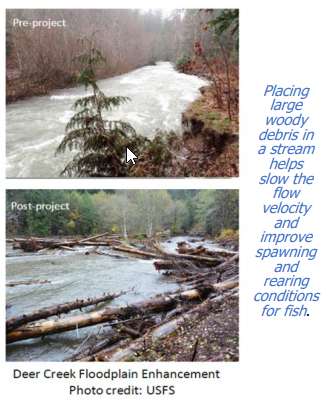
Fish propagation
In the Columbia River Basin the purpose of hatcheries has changed over the last several decades, from primarily providing fish for harvest to raising fish from endemic broodstock to repopulate rivers where fish have declined over time or been extirpated. The 14 hatcheries funded through the Council’s Program that are located upriver of Bonneville Dam have this process, called supplementation, as part of their focus. Ten are operated by tribes. Supplementation is considered an ongoing experiment.
“One of the big questions has been can we use hatcheries to produce fish that can spawn under natural circumstances,” he said.
“So the question is, what can we do to improve the reproductive success of these fish?” Schroder said. “One of the things they are doing is using 100- percent natural-origin broodstock in hatcheries. The Nez Perce and Yakama tribes both are experimenting with 100-percent natural-origin fish. For spring Chinook this appears to be a very powerful way to increase the capacity of these fish to actually produce progeny at a rate comparable to natural-origin fish.”
Steelhead, he said don’t seem to do as well. Typically, it takes wild juvenile steelhead two to three years to get large enough to become smolts.
In hatcheries, the growth of these fish is accelerated and they reach the smolt stage after one year of rearing. Michael Blouin of Oregon State University has hypothesized that steelhead hatchery environments select for aggressive and surface-oriented fish. This occurs because food is broadcast to the water surface. Fish that are aggressive and surface oriented have greater access to food and achieve higher growth rates than less aggressive individuals. It turns out that surface orientation and aggressiveness are heritable traits. Thus, the offspring of hatchery steelhead spawning in nature may exhibit these behaviors, and this would put them at risk particularly to avian predators.
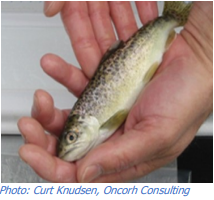
In a hatchery, fish are raised quickly to reach the size when they can be released, but this accelerated rearing has downfalls. “Doing that really disrupts their natural growth patterns, and influences their behavior and their rates of maturation,” Schroder said. “In fact, one of the big problems we have in the basin that is really kind of unidentified is we are potentially releasing millions and millions of precociously maturing male salmon.”
These fish, called minijacks, are destined to mature at age two. Upon release some will stay in their natal streams, many will migrate in mainstem reservoirs and others may even briefly enter seawater. In these environments they will compete with other fish for food and other resources.
He said NOAA researchers studied the propagation techniques at 10 hatcheries and discovered that anywhere from 7 percent to 71 percent of all male yearling Chinook that were released from those hatcheries were precociously maturing.
To resolve the problem of precocious maturation, researchers are focusing on a couple of things to change at hatcheries: reducing the growth of young fish in the fall, and providing fish feed that has a low lipid (fats) content – hence, lower-energy foods. The theory is that these changes could slow fish growth and lead to fewer mini-jacks. Other potential solutions are hatchery-specific, such as adjusting the temperature of a hatchery’s water supply.
Males maturing precociously in a hatchery look a lot like other fish, and so as they grow through the winter months and are released in the spring it’s not evident to the eye which fish will grow and go to the ocean normally and which will mature too quickly.
“It’s extremely accurate,” Schroder said. “If a fish has a high level of this androgen (11- ketotestosterone), it’s going to mature as a two-year -old fish,” he said. “So far we’ve only looked at 10 hatcheries, and we need to survey the additional hatcheries in the basin that produce yearling Chinook and find out how prevalent this problem is, and we need to start evaluating procedures to try to reduce it.”
He said the research work, “in many cases is the best in the world, and it acts as a guide for many projects and additional research around the world.”
“I’ve often asked project sponsors to tell us what has been discovered and why it is important to the region,” Karier said. He said the Council should consider establishing criteria for what constitutes a successful project. “I think what’s most important for us to know are two things. First, are these projects effective – are they producing fish that are healthy, whether it’s through hatchery work or in improved habitats? We’re spending three hundred million dollars a year, and we want to know whether those things are effective and working. And the second thing is, are there other things that we are not doing that we should be doing? Every [project] should go through the screen of what did we learn about the effectiveness of what we do, or what else can we do?”

John is the Council’s information officer. He helps edit and write Council publications, speeches, and news releases. He came to the Council in 1990 from the Columbian, Vancouver, Washington’s daily newspaper, where he was a reporter for six years writing about Northwest energy issues and an editor for four years. He has a bachelor’s degree in communications from Washington State University and a master’s degree in journalism from the University of Oregon. jharrison@nwcouncil.org
Images accompanying this article provided by the Northwest Power and Conservation Council


Advertisement